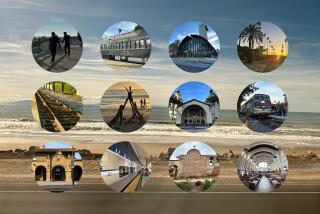Fullerton
- Share via
FULLERTON — Over the clatter of arriving and departing trains, Alford Nichols makes his pitch to passersby at the downtown Transportation Center, urging them to stop at his stand for a $5 shoeshine.
Nichols, known to his customers as Big Smokey, offers his services to depot visitors in the place he says is perfect for his business, buffing commuters’ shoes to a high luster.
“I picked this location because it’s a really nice area,” says Nichols, 55, who began shining shoes in Chicago when he was 13. “It’s a real downtown.”
Nichols, who also reheels and resoles footwear and mends leather bags at his home in Cypress, has been shining shoes in Fullerton for 15 years and is at the train station nearly every weekday.
From his vantage point, he observes that the number of people using the depot appears to have picked up in the past year, and he says he hopes the increased foot traffic will “bring back demand for shoeshines.”
Longtime residents confirm Nichols’ observation that the train station, like the rest of downtown Fullerton, is thriving, and they note that the fortunes of the city have been linked to the railroad for more than 100 years.
After all, the city is named for George R. Fullerton, president of Pacific Land and Improvement Co., who in 1887 persuaded Union Pacific railroad officials to lay tracks here. When the city was established in 1904, residents chose its name in his honor.
The original Union Pacific depot, built in 1922, has been converted to a Spaghetti Factory restaurant. The Atchison, Topeka & Santa Fe station, added in 1930, is one of the oldest depots still in operation in Southern California.
The buildings are part of the city’s Transportation Center, which serves more than 900 Amtrak and Metrolink passengers a day and is a hub for bus service across Orange County. But they are not the only historic sites in this city’s 2-square-mile downtown.
Stately churches and the Fullerton Museum Center on Pomona Avenue, Police Department headquarters in the old City Hall, the old post office on Commonwealth Avenue and the turn-of-the-century commercial structures along Harbor Boulevard are all part of a heritage that residents and officials vowed nearly 30 years ago to save.
“The city created a citizens committee, and we formed goals for Fullerton in 1969,” said A.B. (Buck) Catlin, 78, a former mayor and member of that first preservation group. “We wanted the downtown to remain the center of the city, and we didn’t want to destroy it. It anchored the cultural heritage of the city.”
“The people of Fullerton have been very parochial about the downtown and maintaining the old character,” he said. “It is the heart of the city, a small-town atmosphere, a cultural core that we’ve protected.”
*
Among the rehabilitation projects is the 74-year-old Villa del Sol commercial center on Harbor Boulevard. Formerly the 121-room California Hotel, it is now home to Heroes bar, a baseball collectibles store, a flower shop, a boutique and five-star restaurant the Cellar.
The Spring Field banquet hall, built in 1919, once was a Masonic Temple. The Harbor Boulevard landmark, designed in the Spanish style with wide windows and a tile roof, is now owned by Benjamin Kim, who rents it out for parties.
The Chapman Building, built in 1922 by a group of residents, including Fullerton’s first mayor, Charles C. Chapman, was the tallest structure in Orange County when it opened in 1923. Rehabilitated in 1984, the building on East Wilshire Avenue now houses a bank and office suites.
The Redevelopment Agency, established in 1974, has been instrumental in securing funds for restoration, allocating $18 million for rehabilitation and seismic retrofitting of the train station, nearly $500,000 for Villa del Sol and $650,000 for the banquet hall.
At Mo’s Fullerton Music Centers in a building erected 92 years ago, owner Mo Meloy relates how she was captivated by the old downtown when she moved here 20 years ago from Yakima, Wash.
“I heard the chapel bells ring, I liked the atmosphere, and I never left,” she said. “This is a real downtown, and I love it,” said Meloy, who received $125,000 from the Redevelopment Agency to help restore her building. Altogether, she said, she has invested $5 million in the project.
Meloy, Catlin and other longtime residents say the railroad, in the past and today, may be what first brings people to Fullerton, but the character and charm of the old downtown are what lures them back to visit, to shop and to live.
(BEGIN TEXT OF INFOBOX / INFOGRAPHIC)
It’s Fine In Fullerton
Rehabilitating existing buildings has helped downtown Fullerton thrive and attract a steady stream of visitors.
Fullerton Profile
Established: 1904
Motto: None
Population: 123,700
Median household income: $41,921
Ethnicity: 64% white, 21% Latino, 12% Asian, 2% black, 1% other
Major employers: Hughes Aircraft and Cal State Fullerton, each with about 2,600 employees
Landmarks: Fullerton Museum Center, Muckenthaler Cultural Center, Fullerton Transportation Center, old City Hall
Sources: Fullerton public information office, Federal Housing and Urban Development, U.S. census
(BEGIN TEXT OF INFOBOX / INFOGRAPHIC)
Fullerton’s Cultural Core
Fullerton’s Cultural Core
Rehabilitating existing buildings has helped downtown Fullerton thrive and attract a steady stream of visitors.
*
Fullerton Profile
Established: 1904
Motto: None.
Population: 123,700
Median household income: $41,921
Ethnicity: 64% white, 21% Latino, 12% Asian, 2% black, 1% other
Major employers: Hughs Aircraft and Cal State Fullerton, each with about 2,600 employees
Landmarks: Fullerton Museum Center, Muckenthaler Cultural Center, Fullerton Transportation Center, old City Hall.
Sources: Fullerton public information office, Federal Housing and Urban Development, U.S. Census
More to Read
Sign up for Essential California
The most important California stories and recommendations in your inbox every morning.
You may occasionally receive promotional content from the Los Angeles Times.










